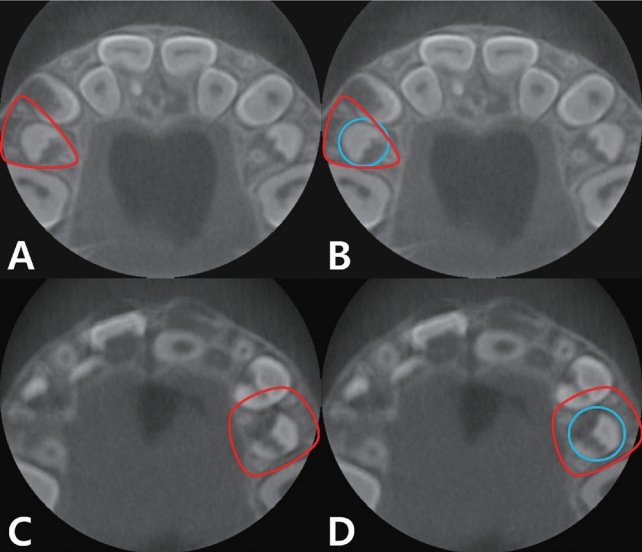1. Korean academy of pediatric dentistry : Textbook of Pediatric Dentistry. 5th ed. Yenang, Seoul, 82-86, 2014.
2. Kovacs I : Contribution to the ontogenetic morphology of roots of human teeth.
J Dent Res, 46:865-874, 1967.


3. Song JS, Kim SO, Lee JH,
et al. : Incidence and relationship of an additional root in the mandibular first permanent molar and primary molars.
Oral Surg Oral Med Oral Pathol Oral Radiol Endod, 107:56-60, 2009.


4. Tu MG, Liu JF, Huang HL,
et al. : Prevalence of three-rooted primary mandibular first molars in Taiwan.
J Formos Med Assoc, 109:69-74, 2010.


5. Srivathsa SH : Prevalence of three rooted deciduous mandibular molars in Indian children.
J Dent Sci Res, 2:14-16, 2015.

6. Song JS, Choi HJ, Kim SO,
et al. : The prevalence and morphologic classification of distolingual roots in the mandibular molars in a Korean population.
J Endod, 36:653-657, 2010.


7. Liu JF, Dai PW, Tu MG,
et al. : Prevalence of 3-rooted primary mandibular second molars among Chinese patients.
Pediatr Dent, 32:123-126, 2010.

8. Yang R, Yang C, Zou J,
et al. : Evaluate root and canal morphology of primary mandibular second molars in Chinese individuals by using cone-beam computed tomography.
J Formos Med Assoc, 112:390-395, 2013.


9. Nagaveni NB, Poornima P, Valsan A, Mathew MG : Prevalence of three-rooted primary mandibular second molars in Karnataka (South Indian) population.
Int J Pedod Rehabil, 3:33, 2018.

10. Mayhall J : Three-rooted deciduous mandibular second molars.
J Can Dent Assoc, 47:319-321, 1981.

11. Curzon ME, Curzon JA : Three-rooted mandibular molars in the Keewatin Eskimo: Its relationship to the prevention and treatment of caries.
J Can Dent Assoc, 38:152, 1972.

12. Jorgensen KD : The deciduous dentition; A descriptive and comparative anatomical study.
Acta Odontol Scand, 14:1-202, 1956.

13. Ozcan G, Sekerci AE, Dogan S,
et al. : Evaluation of root canal morphology of human primary molars by using CBCT and comprehensive review of the literature.
Acta Odontol Scand, 74:250-258, 2016.


14. Sim D, Mah Y : A Study of Root Canals Morphology in Primary Molars using Computerized Tomography.
J Korean Acad Pediatr Dent, 46:400-408, 2019.

15. Kavanagh C, O’sullivan VR : A four-rooted primary upper second molar.
Int J Paediatr Dent, 8:279-282, 1998.


16. Ku J, Lee J, Ra J : Additional Root of the Primary Maxillary Second Molar Possibly Associated with Displacement and Rotation of the Permanent Successor: Two Case Reports.
J Korean Acad Pediatr Dent, 44:116-121, 2017.

17. Korean academy of pediatric dentistry : Textbook of Pediatric Dentistry. 5th ed. Yenang, Seoul. 142-145, 2014.
18. Kim YH, Shiere FR, Fogels HR : Pre-eruptive factors of tooth rotation and axial inclination.
J Dent Res, 40:548-557, 1961.

19. Hayutin DJ, Ralstrom CS : Primary maxillary bilateral birooted canines: report of two cases.
ASDC J Dent Child, 59:235, 1992.

20. Kim Y, Lee SJ, Woo J : Morphology of maxillary first and second molars analyzed by cone-beam computed tomography in a Korean population: variations in the number of roots and canals and the incidence of fusion.
J Endod, 38:1063-1068, 2012.


21. Yang C, Yang R, Zou J : Investigation of root and canal morphology of human primary mandibular second molar by cone-beam CT.
Zhonghua Kou Qiang Yi Xue Za Zhi, 48:325-329, 2013.

22. Taylor RM : Variation in morphology of teeth: anthropologic and forensic aspects. Charles C Thomas Publisher, Springfield, 1978.
23. Taylor RM : Deciduous molar root variation. Hum Biol. 655-698, 1986.

24. Loh HS : Incidence and features of three-rooted permanent mandibular molars.
Aust Dent J, 35:434-437, 1990.


25. Falk WV, Bowers DF : Bilateral three-rooted mandibular first primary molars: report of case.
ASDC J Dent Child, 50:136, 1983.

26. Badger GR : Three-rooted mandibular first primary molar.
Oral Surg Oral Med Oral Pathol, 53:547, 1982.


27. Winkler MP, Ahmad R : Multirooted anomalies in the primary dentition of Native Americans.
J Am Dent Assoc, 128:1009-1011, 1997.


28. Wasserstein A, Brezniak N, Rakocz M,
et al. : Angular changes and their rates in concurrence to developmental stages of the mandibular second premolar.
Angle Orthod, 74:332-336, 2004.

29. Ferreira DCA, Fumes AC, Rossi AD,
et al. : Gubernacular cord and canal-does these anatomical structures play a role in dental eruption?
Rev Bras Odontol, 10:167-171, 2013.


30. Ash AS : Orthodontic significance of anomalies of tooth eruption.
Am J Orthod, 43:559-576, 1957.

31. Messer LB, Cline JT, Korf NW : Long term effects of primary molar pulpotomies on succedaneous bicuspids.
J Dent Res, 59:116-123, 1980.


32. Frank CA : Treatment options for impacted teeth.
J Am Dent Assoc, 131:623-632, 2000.


33. Burch J, Ngan P, Hackman A : Diagnosis and treatment planning for unerupted premolars.
Pediatr Dent, 16:89-89, 1994.

34. Bishara SE, Kommer DD, Youngquist HW,
et al. : Management of impacted canines.
Am J Orthod, 69:371-387, 1976.



















 PDF Links
PDF Links PubReader
PubReader ePub Link
ePub Link Full text via DOI
Full text via DOI Download Citation
Download Citation Print
Print



